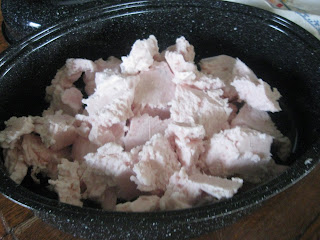div>Lard is not for pansies people – if you cant take the fat, get out of the kitchen! Rendering lard is not a hard task, nor is it really time consuming. A little bit of background on lard is in order.
Lard is made from pig fat and pig fat only. Beef fat is tallow and people use that for soap, bird suet and some people I am sure cook with it, but not this chica – no sir ree….
To start with you must talk to your local butcher and ask him to save you the best pig fat that he can get his greasy little fingers on. When procuring fat you want to be sure its ‘clean’, and by that I mean it has little or no meat particles in it. It is impossible to get completely clean pig fat, but you can get exceptional quality fat if the butcher gives a crap about saving it for you. Our local butchers are GREAT about this and know that if they butcher for us, at times we butcher our own, I will want GOOD fat for lard. They always are pretty proud of their accomplishment and say “See Heidi I got ya the good stuff’ – they’re proud of their trade. Not everyone can be a butcher and do a good job of it. SO, after you have gotten your pig fat – let the fun begin.
Here is what raw pig fat looks like right from the butcher....


You have to put it in a roaster in pieces.



After a little while you will notice a 'scent' in your house that smells a little bit like pigs, but if your butcher did a good job - it should be minimal. See the liquid fat in this roster? This is what you want. I check it and then put it back in until there is more fat melted off. HOWEVER - you dont want to just 'let it cook' you should check on it frequently because the liquid fat will cook the semi solid fat QUICKER than before. Its just like deep frying...if that example helps at all.

See how clear this is - Milk Man happend to walk in and ask me why I had water in the pan... I screamed "YES" thats what I want to hear!! He cocked his eyebrow and said - Lard huh - he knows me well. I didnt use a colonder on this batch because there were not as many small pieces - so a spider works well.
 I let the pans set to cool for a little bit on the counter. You can see that it is getting cloudy as it cools. Once it is semi-solid, I put a lit on it and set it out on the deck were its 13degrees and it will freeze for me.
I let the pans set to cool for a little bit on the counter. You can see that it is getting cloudy as it cools. Once it is semi-solid, I put a lit on it and set it out on the deck were its 13degrees and it will freeze for me. Dont mind the corn - Milk Man was testing the moisture content and left it on the table out there for the birds...
Dont mind the corn - Milk Man was testing the moisture content and left it on the table out there for the birds...
Then I cut it, put it in bags and into the freezer it goes to be used for pie crust, bread or anything that calls for crisco.














